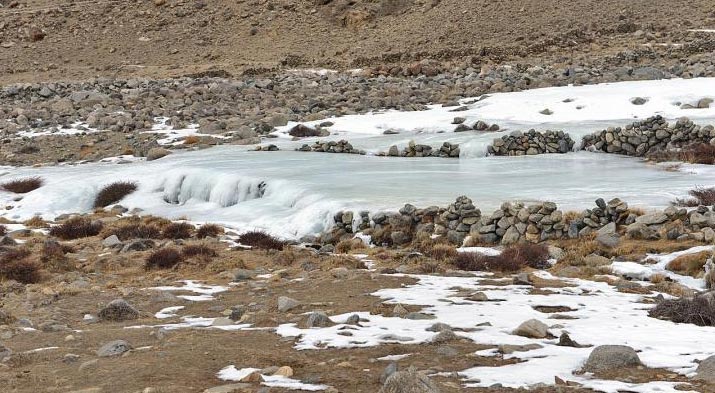Seasonal water resource on the Upper Indus

Aufeis formation in the area of a flat valley section below a springshed at 4,400 meters
Credit: © Marcus Nüsser / Heidelberg University
Heidelberg geographers draw up full inventory of barely researched aufeis (icing) fields.
Seasonally occurring fields of aufeis (icing) constitute an important resource for the water supply of the local population in the Upper Indus Basin. However, little research has been done on them so far. Geographers at the South Asia Institute of Heidelberg University have now examined the spreading of aufeis and, for the first time, created a full inventory of these aufeis fields. The more than 3,700 accumulations of laminated ice are important for these high mountain areas between South and Central Asia, particularly with respect to hydrology and climatology.
In the semi-arid Himalaya regions of India and Pakistan, meltwater from snow and glaciers plays an essential role for irrigation in local agriculture and hydropower generation. In this context, aufeis has been given little attention. It appears as thin sheet-like layers of ice that form through successive freezing of water and can be several meters thick. This phenomenon occurs on a seasonal basis below springsheds, along rivulets or streams under conditions of frequent freeze-thaw cycles.
“In individual cases, this process is deliberately fostered through the construction of stone walls. These artificial reservoirs are used in some valleys of Upper Indus tributaries as water harvesting measures to bridge the seasonal water shortage in spring. However, the amount of ice, size and number of natural aufeis fields have been unknown so far,” underlines Prof. Dr Marcus Nüsser from the South Asia Institute of Heidelberg University.
The Heidelberg geographers have now compiled an inventory of these fields for the whole Upper Indus Basin and, in this context, also analysed the role of topographical parameters such as altitude and slope. The basis were several field campaigns spent in the region along with the evaluation of almost 8,300 Landsat satellite images taken between 2010 and 2020.
With this imagery, the scientists were able to record the characteristic seasonal formation of aufeis and map the annually recurring bodies of ice. They detected over 3,700 aufeis fields, covering a total area of approximately 300 square kilometers. The majority of the aufeis fields lie in the Trans-Himalaya of Ladakh and on the Tibetan Plateau. In contrast, they hardly occur at all in the western part of the Upper Indus region, Marcus Nüsser explains.
The study is part of a project funded by the German Research Foundation about the significance of aufeis and ice reservoirs for the population and agriculture in the Indian region of Ladakh. The participating scientists are studying the effectiveness of the different types of ice reservoirs and whether they function efficiently on a seasonal basis.
“Climate change alters both the melt rate and the annual timing of runoff, which causes increasing uncertainties for irrigated agriculture,” emphasises Prof. Nüsser. “Our findings may contribute to identifying suitable locations for ice reservoirs that can improve seasonal water availability for local farming. In addition, we are going to investigate the extent to which bodies of aufeis can serve as appropriate indicators of climate change.”
The current research findings were published in the journal Science of the Total Environment.
All latest news from the category: Earth Sciences
Earth Sciences (also referred to as Geosciences), which deals with basic issues surrounding our planet, plays a vital role in the area of energy and raw materials supply.
Earth Sciences comprises subjects such as geology, geography, geological informatics, paleontology, mineralogy, petrography, crystallography, geophysics, geodesy, glaciology, cartography, photogrammetry, meteorology and seismology, early-warning systems, earthquake research and polar research.
Newest articles

Innovative 3D printed scaffolds offer new hope for bone healing
Researchers at the Institute for Bioengineering of Catalonia have developed novel 3D printed PLA-CaP scaffolds that promote blood vessel formation, ensuring better healing and regeneration of bone tissue. Bone is…

The surprising role of gut infection in Alzheimer’s disease
ASU- and Banner Alzheimer’s Institute-led study implicates link between a common virus and the disease, which travels from the gut to the brain and may be a target for antiviral…

Molecular gardening: New enzymes discovered for protein modification pruning
How deubiquitinases USP53 and USP54 cleave long polyubiquitin chains and how the former is linked to liver disease in children. Deubiquitinases (DUBs) are enzymes used by cells to trim protein…



